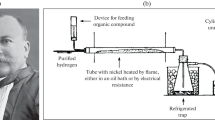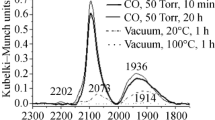Abstract
Together with methane, methanol is the main product of the hydrogenation of CO in the presence of platinum, palladium, and iridium, applied to Y-Al2O3, at atmospheric pressure and temperatures of 473–573 K. Dimethyl ether is also formed on platinum and palladium, while small amounts of ethanol and acetaldehyde are formed on iridium. The hydrogenation of CO in the presence of Rh and Ru leads to the formation of normal C1-C5 alcohols and C2-C5 aldehydes. Reduction of the energy of the metal-carbon bond in the platinum metals (Pd, Ir, Pt, Rh, Ru) increases their specific catalytic activity with respect to the formation of methane and oxygenated organic compounds, and increases the selectivity for higher alcohols and aldehydes.
Similar content being viewed by others
Literature cited
M. A. Vannice, “The catalytic synthesis of hydrocarbons from H2/CO mixtures over the group VIII metlas,” J. Catal.,37, No. 3, 449–473 (1975).
G. I. Golodets, N. V. Pavlenko, and A. I. Tripol'skii, “Some general rules for the hydrogenation of carbon monoxide on metals,” Kinet. Katal.,28, No. 4, 888–895 (1987).
R. Szymanski, H. Charcosset, and V. Perrichon, “(CO, H2) reaction on supported platinum and platinum-zirconium catalysts,” in: 8th Int. Congr. of Catalysis, West Berlin, 1984; Weinheim (1984), pp. 151–161.
K. Tamaru, S. Naito, H. Yosiko, et al., “Mechanisms of CO-H2 reaction on supported palladium catalysts, promoted by alkali metals,” Sekubai,25, No. 5, 326–328 (1983).
N. E. Buyanova, A. P. Karnaukhov, M. M. Kefeli, et al., “Separate determination of the surface of complex catalysts by chromatographic methods,” Kinet. Katal.,8, No. 4, 868–877 (1967).
G. I. Golodets, “Mechanism and kinetics of the hydrogenation of CO on metals,” Teor. Eksp. Khim.,21, No. 5, 549–553 (1985).
K. V. Topchieva, A. A. Kubasov, and Van Dao Thoang, “Dehydration of methanol on alkali forms of X- and Y-type zeolites,” Vestn. Mosk. Univ. Khim.,13, No. 6, 628–632 (1972).
S. S. Batsanov, Electronegative Character of Elements and the Chemical Bond [in Russian], Izd. Sib. Otd. Akad. Nauk SSSR, Novosibirsk (1962).
N. M. Popova, L. V. Babenko, and G. A. Savel'eva, Adsorption and Reaction of the Simplest Gases with Group VIII Metals [in Russian], Nauka, Alma-Ata (1979).
Author information
Authors and Affiliations
Additional information
Translated from Teoreticheskaya i éksperimental'naya Khimiya, Vol. 24, No. 1, pp. 75–81, January–February, 1988.
Rights and permissions
About this article
Cite this article
Il'chenko, N.I., Shmyrko, Y.I. & Golodets, G.I. Hydrogenation of carbon monoxide on platinum metals. Theor Exp Chem 24, 68–74 (1988). https://doi.org/10.1007/BF01392193
Received:
Issue Date:
DOI: https://doi.org/10.1007/BF01392193




